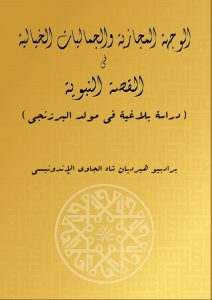 Metaphor is considered as a form of a figure of speech that has multiple meanings, which are connotative and denotative meanings, and has aesthetic values and creativity of imagination. And in literary works, both poetry and prose such as the Maulid Barzanji book are considered to contain metaphorical words in telling the story of the Prophet, whether it is the story of the birth, the miracles, or the characteristics. Meanwhile, historical sources from news, stories, and hadith narration use many non-metaphorical words. Based on this, this research aimed to describe and analyze the forms of the metaphorical dimensions and the aesthetic of imagination in the aesthetics of the Maulid Barzanji Book. In addition, this research also aimed to determine the effect caused by the use of these imaginational and metaphorical words or sentences on the purpose of meaning.
Metaphor is considered as a form of a figure of speech that has multiple meanings, which are connotative and denotative meanings, and has aesthetic values and creativity of imagination. And in literary works, both poetry and prose such as the Maulid Barzanji book are considered to contain metaphorical words in telling the story of the Prophet, whether it is the story of the birth, the miracles, or the characteristics. Meanwhile, historical sources from news, stories, and hadith narration use many non-metaphorical words. Based on this, this research aimed to describe and analyze the forms of the metaphorical dimensions and the aesthetic of imagination in the aesthetics of the Maulid Barzanji Book. In addition, this research also aimed to determine the effect caused by the use of these imaginational and metaphorical words or sentences on the purpose of meaning.
This research is a qualitative descriptive-analytical research with balāghah science as an introduction and literary formalism approach as a concept. The main data source is obtained from the Mawlid al-Barzanji book as the object of research, while the second data source is obtained from books, research journals, and articles related to the theory of balāghah science and classical Arabic literary criticism. Data analysis in this research was conducted through the method of Miles and Huberman (1994: p. 30) which consists of several stages, namely data collection, data reduction, data analysis, and drawing conclusions.
The results of this research indicate that the form of psychological metaphorical dimensions in the aesthetics of the Mawlid al-Barzanji book, in terms of language style is manifested through the use of declarative and non-declarative simile language styles, which are the resemblance of inanimate objects to living things and the resemblance of something sensory to something non-sensory. And as for the form of psychological metaphorical dimensions in the aesthetics of the Mawlid al-Barzanji book, from an imaginative point of view, it is manifested through the use of words containing creative imagination, associative imagination, and interpretative imagination. The use of imagination is intended to describe the strength of the character and its accuracy with the intended purpose, the strong resemblance of the eccentric element, the novelty in symbolizing the explanation. The implications that arise from the use of these imaginational and metaphorical words and sentences for meaning are symbolic shifts aimed at summarizing, embellishing, and explaining sentences.
The findings in this research strengthen and expand the ideas of Zainab Yusuf’s (1994) research on the metaphorical theory of Abd al-Qahir al-Jurjani, as well as research by Himah Istomah (2017) regarding the contents of the Maulid Barzanji book related to the characteristics of the Prophet Muhammad. And the findings of this research contradict the research of Fadil Munawar (2017) which prioritizes the extrinsic aspects of literature as local culture without paying attention to the intrinsic aspects of literature as one of the beauties of language.
